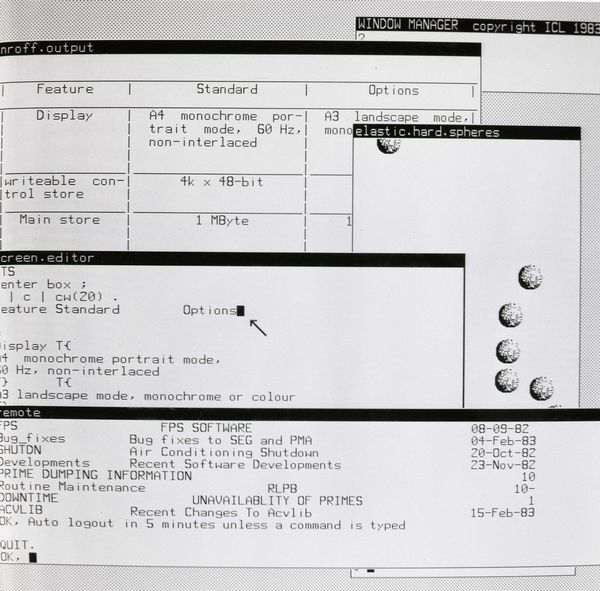

The advent of cheap high-power Single User Computer Systems, providing quality graphics and good interaction as well as significant processor power, enables a new style of computing to be done. The number of types of such systems will increase rapidly over the next few years.
To take advantage of the power offered by such systems, while preventing the inevitable massive software duplication that would result from uncoordinated supply, SERC decided to institute a common base policy, which recommended both hardware and software standards for SERC researchers using such Single User Systems. In brief, the software common base consists of the UNIX operating system, Fortran 77 and Pascal compilers, and the GKS graphics system. The hardware common base consists of ICL PERQ computers, connected by fast Cambridge Rings locally, and by the X25 network nationally. We describe here the PERQ, the software which is now available, and the way in which their use will greatly improve the interaction between man and computer.
The PERQ consists of:
The UNIX [UNIX is a trademark of Bell Laboratories] operating system for the PERQ - called PNX - is now available (PNX is a virtual memory version of UNIX, with a full 32 bit address space). UNIX is a powerful multi-process operating system with many user-oriented tools known as utilities. There are 104 of these standard UNIX utilities available, with a further 13 either specific to PNX or that have required modification in some way.
The PNX window manager provides an essential element of the new style of computing environment. A window is a rectangular area either wholly or partially on the screen: windows may overlap, one (or more) partially obscuring the contents of others. Typically, each window is used as the output device by separate processes running at the same time in PNX. The window manager, as well as allowing creation and deletion of windows, also permits windows to be moved or changed in size. Further, windows can be pushed or popped relative to other windows; this means that a window which obscures other windows can be lowered in visual priority so that a window at the top can be placed below others, and vice versa. (An analogy is a number of documents on a desk, partially overlapping; each document corresponds to a window, with the desk top as the PERQ screen. A letter, say, can be popped to the top of the pile - and thus made wholly visible - by lifting it out of the pile and placing it on top). The window manager also keeps track of information which is obscured so that, if a covered window is uncovered, the information formerly not visible is still available for display.
The figure on this page shows the power of the combination of a multi-process operating system such as UNIX together with such a window manager. A photograph of a session which has five windows generated is shown; one of these windows - at the top right-hand comer of the screen - is for communication with the window manager itself. At the top left-hand comer, the window entitled Droff.output contains information generated by the UNIX tbl and Droff utilities - in this case a table describing PERQ features. The window immediately below (labelled screen editor) shows the thief screen editor editing the input file for tbl. Thus, as errors in this output window are identified, they can be immediately corrected by editing the input file.
Output from two other processes is also shown; one a simulation of perfectly elastic colliding spheres in a container. The other shows the use of the chatter utility to access one of the Prime computers at Rutherford Appleton Laboratory to obtain the message of the day prior to initiating a file transfer.
The simple session described above shows the strength of PNX in a programming development environment. Equally large and complex applications such as occur in computer aided design can be very effectively managed, with several types of input and output information available to the designer and under his direct control. It should be stressed that powerful single user systems and their associated software - as described above - are important because they provide vastly improved communication between the user and the computer. Over the next few years, developments in this area will revolutionise SERC researchers' view of computing.
